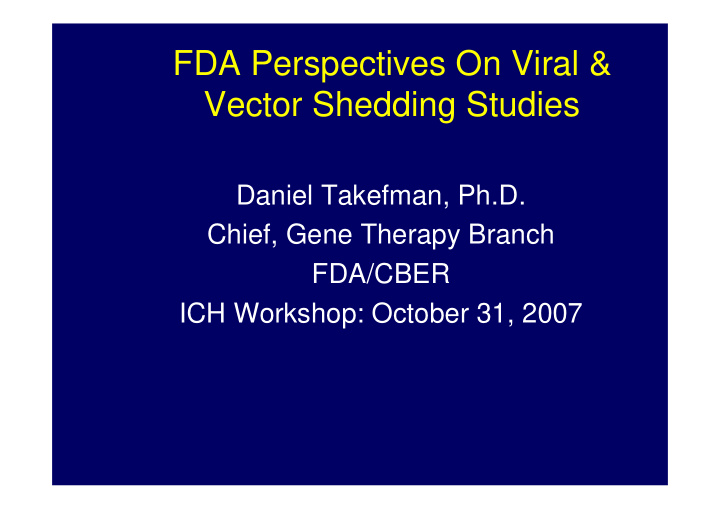



FDA Perspectives On Viral & Vector Shedding Studies Daniel Takefman, Ph.D. Chief, Gene Therapy Branch FDA/CBER ICH Workshop: October 31, 2007
Overview Define shedding studies � Outline basis for need of shedding � studies Provide general considerations for design � of shedding studies Outline differences in shedding studies � performed for public health concerns and for environmental concerns
Viral/Vector Shedding-Definition Virus/Vector excretion outside of body � Urine, feces, saliva, other � Virus/Vector spread within body can be � considered biodistribution
Shedding Studies-Why and When Public health concerns- human to human � spread Addressed during initial clinical studies � Environmental concerns � Used to provide information for environmental � assessment (EA) Part of license application �
Viral/Vector Shedding- Considerations for INDs Public Health Concerns � Regulations/guidance- no specific � guidance Public Health Service (PHS) Act � Prevention of spread of communicable � diseases FDA approach for shedding studies � Science and risk based � Not prescriptive and considered in the context � of the proposed clinical study
Viral/Vector Shedding- General Considerations for INDs Factors used to assess need for and design of � shedding studies for initial clinical trials Virus/Vector properties � Route of administration (ROA) � Dose � Indication � Pre-clinical animal studies � Prior experience � Ex vivo transduced cells not typically � considered
Viral/Vector Shedding- Considerations for pre-clinical studies In conjunction with pre-clinical animal studies, � not a stand alone study Relevance of animal species and disease model � Tropism � Biodistribution / Pharmacokinetics � Viral Replication � Clearance � Immune response � Disease model characteristics � e.g. tumor model for oncolytic vectors �
Viral Shedding- Considerations for pre-clinical studies Detection Assays � PCR � FDA guidance for LTFU � Infectivity � Samples for analysis � Sample time points � Horizontal transmission studies �
Viral Shedding- Considerations for Clinical Studies Clinical shedding studies � Data from pre-clinical studies � Virus/Vector considerations � Replication competent vs. incompetent � Biology (mode of transmission, ability to � recombine, etc.)
Viral/Vector Shedding- Considerations for Clinical Studies Samples for analysis � Based on route of administration � Analysis of urine if injection into bladder � Analysis of saliva and/or nasopharyngeal � swabs for head & neck cancer Detection assays � PCR vs. Infectivity, step wise approach � Time points �
Viral Shedding- Considerations for Clinical Studies Horizontal transmission studies � Virus/Vector found to shed � ROA that has high risk for transmission � Complexity/ Logistics � Sample collection procedure to avoid � mix-ups Adequacy of sample collection �
Environmental assessment The National Environmental Assessment � Policy Act of 1969 (NEPA) Requires all Federal agencies to assess the � environmental impacts of their actions Inform the public � FDA regulations 21 CFR part 25 � Environmental assessments (EAs) must be � submitted as part of IND, NDA, BLA, and supplements
Environmental assessment- exclusions Investigational New Drug (IND) � Application Can request categorical exclusion � [21CFR25.31(e)] Small scale production, low number of � clinical trial participants Required if extraordinary circumstances � indicate that the specific proposed action may significantly affect the quality of the human environment (21CFR 25.21)
Environmental assessment- exclusions Biologics license application (BLA) � Categorical exclusion if � Substance is naturally occurring in the � environment [21CFR25.31(c)] Approval will not increase the use of an � active moiety [21CFR 25.31 (a)] Applications for marketing approval of a � biologic product for transfusable human blood or blood components or plasma [21 CFR 21.31 (j)]
Shedding Studies- Considerations Relating to Environmental Assessment Shedding studies can inform EAs � No substance is shed � Substance is shed, but in a degraded � form � Role of infectivity assays Point of entry into the environment �
Shedding Studies vs. Environmental Assessment Some products may warrant shedding studies for � public health concerns, but may be categorically excluded from EA requirements if “naturally occurring” Oncolytic viruses containing no transgene � Some products that are not assessed in shedding � studies for public health concerns may need EA (e.g. plasmids) Currently no experience with EAs for gene � therapy products as no products have been licensed
Summary Shedding studies performed at initiation � of IND for public health concerns Science and risk based approach � Need and design based on numerous factors � specific to the product and clinical study Shedding studies can be performed to � inform EAs EAs part of license application �
Recommend
More recommend